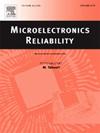Rapid on-site nondestructive surface corrosion characterization of sintered nanocopper paste in power electronics packaging using hyperspectral imaging
IF 1.6
4区 工程技术
Q3 ENGINEERING, ELECTRICAL & ELECTRONIC
引用次数: 0
Abstract
Sintered nanocopper (nanoCu) paste, exhibiting excellent electrical, thermal, and mechanical performances, offers promise for interconnections in wide bandgap (WBG) semiconductors operating at higher temperatures. However, sintered nanoCu is prone to severe corrosion in environments containing H2S, with on-site characterization methods for the composition of corrosion products currently lacking. In this study, a novel method was proposed for the rapid characterization of corrosion products during the corrosion process based on hyperspectral imaging (HSI) technology. Sintered nanoCu samples were subjected to 336 h H2S gas corrosion tests with bulk Cu as the reference, followed by correlating the corrosion element content with hyperspectral characteristic parameters. Then, the morphology and composition of corrosion products were researched using focused ion beam scanning electron microscope (FIB-SEM) and transmission electron microscope (TEM) analysis. The results showed that (1) during the corrosion process, a linear relationship was established between the Cu, O elemental atomic contents on the sample surfaces and their hyperspectral characteristic parameters. (2) The elemental atomic content of S exhibited an exponential relationship with the characteristic parameter. (3) The change rate in the spectral characteristic parameters during the corrosion process reflected the severity of corrosion, which was confirmed by comparing the thickness of the corrosion products of the sintered nanoCu and bulk Cu. This study offers a foundation for the further investigation of rapid on-site characterization of sintered nanoCu corrosion involving H2S.
利用高光谱成像技术对电力电子器件封装中的烧结纳米铜浆进行快速现场无损表面腐蚀表征
烧结纳米铜(nanoCu)浆料具有优异的电气、热和机械性能,有望在更高温度下工作的宽带隙(WBG)半导体中实现互连。然而,烧结纳米铜在含有 H2S 的环境中容易受到严重腐蚀,目前还缺乏现场表征腐蚀产物成分的方法。本研究提出了一种基于高光谱成像(HSI)技术的新方法,用于在腐蚀过程中快速表征腐蚀产物。以块状铜为参照物,对烧结纳米铜样品进行 336 小时 H2S 气体腐蚀试验,然后将腐蚀元素含量与高光谱特征参数相关联。然后,利用聚焦离子束扫描电子显微镜(FIB-SEM)和透射电子显微镜(TEM)分析研究了腐蚀产物的形态和组成。结果表明:(1) 在腐蚀过程中,样品表面的 Cu、O 元素原子含量与其高光谱特征参数之间呈线性关系。(2) S 元素原子含量与特征参数呈指数关系。(3)腐蚀过程中光谱特征参数的变化率反映了腐蚀的严重程度,这一点通过比较烧结纳米铜和块状铜的腐蚀产物厚度得到了证实。这项研究为进一步研究涉及 H2S 的烧结纳米铜腐蚀的快速现场表征奠定了基础。
本文章由计算机程序翻译,如有差异,请以英文原文为准。
求助全文
约1分钟内获得全文
求助全文
来源期刊

Microelectronics Reliability
工程技术-工程:电子与电气
CiteScore
3.30
自引率
12.50%
发文量
342
审稿时长
68 days
期刊介绍:
Microelectronics Reliability, is dedicated to disseminating the latest research results and related information on the reliability of microelectronic devices, circuits and systems, from materials, process and manufacturing, to design, testing and operation. The coverage of the journal includes the following topics: measurement, understanding and analysis; evaluation and prediction; modelling and simulation; methodologies and mitigation. Papers which combine reliability with other important areas of microelectronics engineering, such as design, fabrication, integration, testing, and field operation will also be welcome, and practical papers reporting case studies in the field and specific application domains are particularly encouraged.
Most accepted papers will be published as Research Papers, describing significant advances and completed work. Papers reviewing important developing topics of general interest may be accepted for publication as Review Papers. Urgent communications of a more preliminary nature and short reports on completed practical work of current interest may be considered for publication as Research Notes. All contributions are subject to peer review by leading experts in the field.
 求助内容:
求助内容: 应助结果提醒方式:
应助结果提醒方式:


